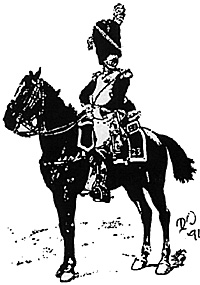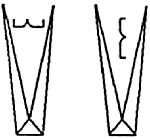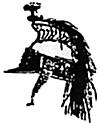 Wargamers being what wargamers are, myself included, have a tendency
to collect all manner of exotic troops and/or units whose conduct
brought them to the fore of the history books. All well and good,
but would it not be better to assemble brigades and divisions that
were accurate at least as far as unit identity was concerned? Instead
of having a favourite unit, would it not be better to build a personal
association with a command?
Wargamers being what wargamers are, myself included, have a tendency
to collect all manner of exotic troops and/or units whose conduct
brought them to the fore of the history books. All well and good,
but would it not be better to assemble brigades and divisions that
were accurate at least as far as unit identity was concerned? Instead
of having a favourite unit, would it not be better to build a personal
association with a command?
In the Napoleonic Wars, the grouping of Regiments was generally consistent, encouraging a larger esprit d'corps within a brigade. It made logical sense that a battalion should feel confident of not only it's own regiments battalions but also confident of the units that it was brigaded with. Thus when studying orders of battle you will notice a trend throughout the campaigns, that once established brigades maintained the same composition wherever possible. Divisions retained the same brigades, and so on for Corps. This was common with all armies and not just the French. Only a major disruption, such as the destruction of the Prussian Army in 1806, tended to break these ties. Reorganisations, such as that of Arch Duke Charles to the Austrian Army, caused similar fractures, but even then the disjointing was resisted where possible.
This article is the first in a series that will highlight such commands, detailing the uniforms, facings, commanding officers and strengths of formations throughout various campaigns. It is intended to encourage you to collect and assemble commands rather than the usual hotchpotch of units that appear on wargames tables. Imagine the scene, passing member of the public says "Who are they?". Would you rather reply "Oh that's the 1st Foot and Mouth" or in a rather more dignified manner "That's the 23rd Brigade, Part of III Corps, they fought at...". Credibility or what?
The Evolution of the French Dragoons of the Army of Italy
The regiments that we are concerned with here, primarily the 7th, 23rd, 28th and 30th Dragoons, from 1804 to 1809, were attached to the Army of Italy. They were engaged in Italian theatre of operations during the Campaigns at this time.
The 1809 Campaign
In April 1809 the Army of Italy, under the Viceroy Eugene comprised 9 divisions of Infantry and 2 divisions of Dragoons.
These cavalry were organised as follows;
- 1st Dragoon Division, commanded by Lieutenant General Grouchy
- 7th Dragoons 4 Squadrons
30th Dragoons 4 Squadrons
Reina Dragoons (1st Italian) 4 Squadrons
4th Coy. 2nd Horse Artillery 4 x 4pdr Cannon, 2 x 6p Howitzers
2,350 Sabres, 6 Cannon & 125 Crew
2nd Dragoon Division, commanded by Lieutenant General Pully
- 23rd Dragoons 4 Squadrons
28th Dragoons 4 Squadrons
29th Dragoons 4 Squadrons
1,650 Sabres
These divisions were subsequently combined with a 3rd Light Cavalry Division to form the `Cavalry Reserve of the Army of Italy'. Grouchy rose to command the reserve and his division was given to Major General Guedin D'Estoquigny.
They fought at the Piave on 8th May 1809 and then missed the Battle of Aspern Essling.
Grouchy subsequently found himself commanding III (Infantry Corps) and D'Estoquigny found his division reduced to the status of 3rd brigade within the 1st Division of Lieutenant General Montbrun. the 1st and 2nd Brigades were comprised of Light Cavalry under Jacquinot and Colbert respectively. Pully still maintained his status as a division commander.
At Raab 14th June 1809, the `Cavalry Reserve of the Army of Italy' stood as follows.
1st Division, Lt.Gen Montbrun
- 1st Brigade Jacquinot 1,516 Sabres in 10 squadrons, 6 x 4pdr cannon
2nd Brigade Colbert 1,771 in 10 squadrons
3rd Brigade D'Esoquigny
- 7th Dragoons 4 Squadrons 607 sabres
30th Dragoons 4 Squadrons 848 sabres
Reina Dragoons (1st Italian) 4 Squadrons 629 sabres
4th Coy. 2nd Horse Artillery 4 x 4pdr Cannon, 2 x 6p Howitzers 100 crew
2nd Dragoon Division, commanded by Lieutenant General Pully
- 23rd Dragoons 4 Squadrons 538 sabres
28th Dragoons 3 Squadrons 383 sabres
29th Dragoons 4 Squadrons 549 sabres
Not surprisingly, the next major action was at Wagram, but the integration of our dragoons into the Grande Armee, had already begun. In fact the days of the Army of Italy as an independent force were already numbered.
At Wagram, Grouchy had been happily restored to command of the 1st Division, which had now reverted from being a brigade. The 1st and 2nd Divisions were grouped with a 3rd Division (Light Cavalry) under Montbrun and detached to Davout on the right wing.
The organisation for Wagram is as follows:
1st Division, Grouchy
-
7th Dragoons 4 Squadrons 492 sabres
30th Dragoons 4 Squadrons 711 sabres
Reina Dragoons (1st Italian) 4 Squadrons 546 sabres
4th Coy. 2nd Horse Artillery 4 x 4pdr Cannon, 2 x 6p Howitzers, 120 crew
2nd Division, Pully
-
23rd Dragoons 4 Squadrons 403 sabres
28th Dragoons 3 Squadrons 255 sabres
29th Dragoons 4 Squadrons 451 sabres
3rd Division, Montbrun
- 1219 Sabres in 10 Squadrons
The 1812 Campaign
In 1812 Grouchy was elevated to the status of III Reserve Cavalry Corps commander, the above divisions were again relegated to the status of brigade and were the 1st and 2nd Brigade of the 6th Heavy Cavalry Division. As you can see the link with their old commander was maintained, even though at unit level some were transferred out and a couple exchanged brigades. Command of the 6th Heavy Cavalry Division was passed to General de Division Lahoussaye.
Order of Battle 15 August 1812
6th Heavy Cavalry Division, Lahoussaye
-
1st Brigade, Thiry
-
7th Dragoons 3 Squadrons 406 sabres
23rd Dragoons 3 Squadrons 445 sabres
(Brigade Total 851. June 1812 Brigade Total was 1177)
2nd Brigade, Seron (former Colonel of the 7th Dragoons)
- 23rd Dragoons 3 Squadrons 435 sabres
30th Dragoons 3 Squadrons 255 sabres
(Brigade Total 690. June 1812 Brigade Total was 1213)
Attached Artillery.
- 4th & 5th Coys. 4th Horse Artillery. 4 x 6pdrs and 2 Howitzers each.
In case you were wondering what happened to the 29th Dragoons and the Reina Dragoons. In 1811 the 29th were converted into the famous 6th Lancer Regiment, and became part of the 9th Light Cavalry Brigade, attached to Ney's III Corps. The 6th distinguished itself many times between 1812 and 1815.
The Reina Dragoons were transferred to the Italian Guard Brigade of Eugene's IV Corps.
The 1813 Campaign
Following the devastation of the 1812 Campaign, the French Cavalry suffered from a severe remount shortage. The 6th Heavy Cavalry Division of 1812 was no more. It's four regiments found themselves combined into a brigade, and serving as the 2nd brigade of the 3rd Heavy Cavalry Division in Latour Maubourg's, I Reserve Cavalry Corps.
Order of Battle for 25th April 1813
3rd Heavy Cavalry Division, Doumerc
-
1st Brigade, Thouard
-
4th Cuirassiers
7th Cuirassiers
14th Cuirassiers
(Brigade Total c.103)
2nd Brigade, ?
- 7th Dragoons 1 Squadron 119 sabres
23rd Dragoons 1 Squadron 125 sabres
23rd Dragoons 1 Squadron 119 sabres
30th Dragoons 1 Squadron 134 sabres
Order of Battle for 15th August 1813
3rd Heavy Cavalry Division, Doumerc
-
1st Brigade, Lalaing d'Audenarde
- 4th Cuirassiers 3 Squadrons 404 sabres
7th Cuirassiers 3 Squadrons 291 sabres
14th Cuirassiers 2 Squadrons 242 sabres
Napoleon (2nd Italian) Dragoons 4 Squadrons 617 sabres
2nd Brigade, Reiset
-
7th Dragoons 1 Squadron 119 sabres
23rd Dragoons 1 Squadron 125 sabres
23rd Dragoons 1 Squadron 119 sabres
30th Dragoons 1 Squadron 134 sabres
In the 1812 and 1813 campaigns I Reserve Cavalry Corps saw action at most of the important battles including Leipzig and Dresden.
The Restoration of the Bourbon dynasty in 1814 saw the 23rd and 28th Regiments disbanded as their recruiting areas were no longer part of France. I suspect also that in practice so was the 30th, who according to one source were finally disbanded in October 1815.
The 7th Dragoons were brigaded with the 2nd Dragoons during 1815, as part of III Cavalry Corps under Kellerman.
The 7th fought at Waterloo with 4 squadrons present under the command of Colonel Leopold, 41 officers and 475 men were present and under arms on 1st June 1815.
Uniform Details
Tunic Prior to 1812, a middle green, long tailed habit was worn over a white waist coat. After that date a short tailed habit veste was adopted by all regiments. Facing colours were worn on the Lapels, Turnbacks, cuffs, cuff flaps and collars. See the table below. Trumpeters wore habits of the regimental colour, although the 1812 regulations subsequently specified that Imperial green livery should be worn for all musicians. It should be remembered that old uniform stocks and the regimental pride instilled in to such a distinctive, meant that this regulation was resisted by many, possibly as late as 1814.
| Regt. | Lapels | Turnbacks | Cuffs | Cuff Flaps | Collar | Pockets |
|---|---|---|---|---|---|---|
| 7th | Red | Red | Red | Red | Red | Horizontal |
| 23rd | Yellow | Yellow | Yellow | Green | Green | Vertical |
| 28th | Orange | Orange | Orange | Orange | Orange | Vertical |
| 29th | Orange | Orange | Orange | Green | Green | Vertical |
| 30th | Orange | Orange | Green | Orange | Green | Vertical |
 In the above table the Pockets referred to are the false pockets which
were piped in the facing colour and displayed on the coat tails. Vertical
and Horizontal relate to the manner in which they were worn. See diagram below.
In the above table the Pockets referred to are the false pockets which
were piped in the facing colour and displayed on the coat tails. Vertical
and Horizontal relate to the manner in which they were worn. See diagram below.
Where a `facing' was green it was piped in the Regimental colour. Where a 'facing' was of the Regimental colour it was piped in green.
Legwear For Parade dress calf length off white riding breeches. On campaign grey or green overalls with piping in regimental colour or lace.
 Headgear Yellow alloy metal (cuivre) peaked helmet, surmounted by
a black horsehair mane, (white for trumpeters), and a brown fur turban.
Contemporary illustrations show that the turban for officers tended
to be Leopard skin. For a parade dress a plume was worn. There is
no definitive table on dragoon plumes as they varied from year to
year and on occasion from squadron to squadron. However, you won't
go far wrong with the following;
Headgear Yellow alloy metal (cuivre) peaked helmet, surmounted by
a black horsehair mane, (white for trumpeters), and a brown fur turban.
Contemporary illustrations show that the turban for officers tended
to be Leopard skin. For a parade dress a plume was worn. There is
no definitive table on dragoon plumes as they varied from year to
year and on occasion from squadron to squadron. However, you won't
go far wrong with the following;
-
7th Red over Black, or Red over Green
23rd Red over Black, or Yellow over Green, or all White
28th White
29th White
30th Red
Elite companies wore the bearskin common with line infantry grenadier companies. Abolished in 1812, it remained in use in many regiments through to 1814.
Horse Furniture Prior to 1812, the pistol covers and horse cloth were middle green, edged with 45mm wide white lace. As was the rectangular portemanteau, carried behind the rider. The 1812 Regulations sanctioned the already common practice of covering the entire saddle with a white sheepskin shabraque. This was to be edged in "wolves' teeth" edged in the Regimental colour. Officers sheepskins were black.
Regimental Organisation
The ideal organisation, rarely achieved through lack of men or horses was as follows;
Regimental Staff, 15 Officers and Men (Includes 8 Sappers)
Four Squadrons, each of two companies.
Company strength was supposed to be 3 Officers and 90 men.
This would give a regimental total of 759 all ranks. As can be seen for the Orders of Battle above, this figure was never attained in the field.
Suggested Further Related Reading
-
Napoleon's Cavalry and Its Leaders, Johnson D.
Napoleon's Cavalry, Bukhari & McBride
Borodino, Duffy
Armies on the Danube 1809, Bowden
Napoleon's Grande Armee 1813, Bowden
A Year at War 1809, Sapherson.
Back to Table of Contents -- First Empire #4
Back to First Empire List of Issues
Back to MagWeb Master Magazine List
© Copyright 1991 by First Empire.
This article appears in MagWeb (Magazine Web) on the Internet World Wide Web. Other military history articles and gaming articles are available at http://www.magweb.com